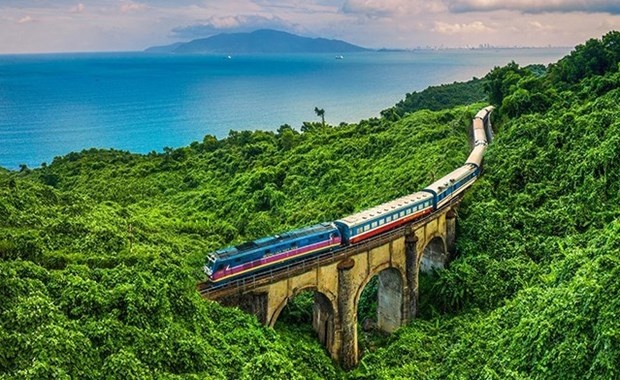Ray of hope for prolonged Vietnam Railways merger
 |
| Ray of hope for prolonged Vietnam Railways merger, Illustrative image (Photo: VNA) |
The government on April 7 approved Vietnam Railways’ (VNR) proposal to merge Hanoi Railway Transport JSC (Haraco) and Saigon Railway Transport JSC (Saratrans) into one unit.
The corporation then plans to work on the separate establishment of a passenger transport unit and a cargo transport unit to increase operational efficiency.
At present, both Haraco and Saratrans under VNR are operating passenger and cargo transport in an independent manner, which includes different promotional programmes and ticket prices, causing internal competition in the ailing industry.
VNR chairman Vu Anh Minh said, “The move is expected to put an end to this internal competition, thus enabling the industry to increase efficiency and competitiveness, and to attract private investment.” VNR plans to sell stakes in the cargo transport unit to potential financiers to attain such private investment.
The restructuring plan has been in the works for several years, with strategies first submitted to authorised agencies in 2017, but inevitably, legal barriers and other disagreements have been tough to iron out.
In an effort to realise the plan, VNR has worked with the Commission for the Management of State Capital at Enterprises on the separation of some parts in the long-awaited 2021-2025 restructuring plan to be approved first, with the merger being included in that plan.
More fresh opportunities for private investors and businesses are expected to come as the separation also includes investment in the construction of warehouses and inland container depots (ICDs); upgrading and development of railway stations into trade centres and offices for lease in line with the Law on Railways 2017; and upgrading of railway routes connecting with China.
When the two units officially merge, VNR will find itself with too many workers. The chairman admitted that it could take around nine months to complete the merger, with changes in the two units’ operations and workforce going along with that.
“Many solutions and measures are being worked out to ensure jobs for all,” Minh noted.
Legal barriers have so far hindered VNR from making its next steps with potential partners, which includes a cooperation agreement with Saigon Newport Corporation to develop ICDs and warehouses at Song Than, Dieu Tri, Yen Vien, Dong Anh, and Dong Dang stations, with the plan to develop more in the future.
Another problematic case is Lotte E&C’s proposal to invest in the second phase of upgrades to the Yen Vien-Lao Cai railway route, as well as Toyota’s plan to build a railway route connecting its factory in the northern province of Vinh Phuc to the main North-South network, using
Danang railway station as a transhipment hub to other provinces in the central region.
Experts said that lessons from other countries show that railways have proven difficult for the public-private partnership model and Vietnam is not an exception, although transport is one of the six sectors that are covered in the Law on Public-Private Partnership Investment.
The track is expected to be more favourable when a master plan in line with Decree No.46/2018/ND-CP governing the management and use of railway infrastructure assets is approved. Included is VNR’s proposal to hand over 297 railway stations, warehouses, and ICDs to own, use, and develop with assets to be recorded as state capital contribution to the operator.
The VNR chairman elaborated that positive signals have come as most of the issues in this proposal have been agreed upon. “The only problem now is the handover of the railway stations, but the Ministry of Transport is working on it. We expect all issues will be dealt with, and Decree 46 will be approved soon to facilitate our next steps,” he explained.
VNR and its units have faced some major losses over the past two years. In 2021, VNR reported a loss of around $30 million. Haraco and Saratran also faced a similar situation – the former saw its net revenues fell 20 per cent on-year and a loss of $5.28 million in after-tax profit.
Meanwhile, the latter’ net revenues dropped 28.7 per cent on-year and lost $6.04 million. This year, VNR will focus on cargo transport with the aim to make just over $25 million in pre-tax profit.
What the stars mean:
★ Poor ★ ★ Promising ★★★ Good ★★★★ Very good ★★★★★ Exceptional
 Tag:
Tag:
Related Contents
Latest News
More News
- MCH to become the largest consumer stock on VN-Index (December 24, 2025 | 11:05)
- Oil and gas firms post strong 2025 results (December 22, 2025 | 17:42)
- SABECO wins multiple international beer awards (December 22, 2025 | 17:41)
- UOB sees Vietnam growth easing in fourth quarter (December 22, 2025 | 17:39)
- First members of Danang International Finance Centre revealed (December 22, 2025 | 17:39)
- Human-centred governance seen as key to AI development (December 19, 2025 | 18:19)
- Top 10 notable events of Vietnam’s industry and trade sector in 2025 (December 19, 2025 | 14:00)
- Tungsten surges to 12-year high as world enters a new 'black gold' race (December 18, 2025 | 17:27)
- Vietnam’s coffee exports set new record despite price pressures (December 18, 2025 | 17:13)
- Garment and textile sector seeks new growth after volatile year (December 18, 2025 | 17:01)





















 Mobile Version
Mobile Version